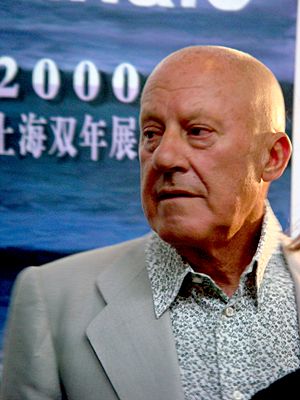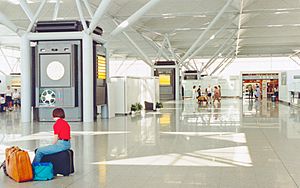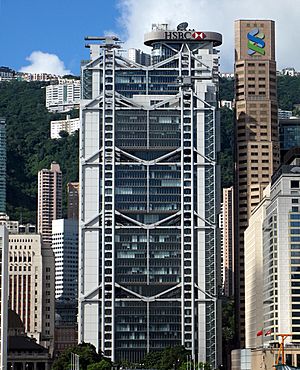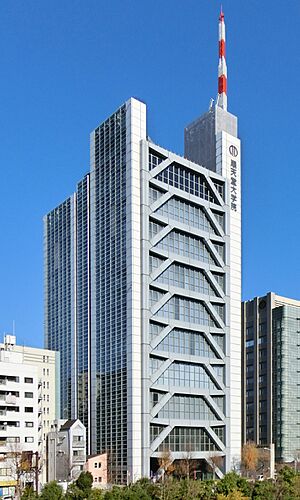Norman Foster, Baron Foster of Thames Bank facts for kids
Quick facts for kids
The Lord Foster of Thames Bank
|
|
|---|---|

Norman Foster in 2008
|
|
| Born |
Norman Robert Foster
1 June 1935 Reddish, Stockport, England
|
| Alma mater | University of Manchester Yale University |
| Occupation | Architect |
| Spouse(s) |
Begum Sabiha Rumani Malik
(m. 1991; div. 1995)Elena Fernández-Ferreiro López de Ochoa
(m. 1996) |
| Children | 5 |
| Awards |
|
| Practice | Foster + Partners |
| Buildings |
|
| Projects | American Air Museum at the Imperial War Museum Duxford |
Norman Robert Foster (born 1 June 1935) is a famous English architect and designer. He is known for his unique style called "high-tech architecture." This style uses modern technology and materials to create buildings that look futuristic. Foster is a very important person in British modern architecture.
His company, Foster + Partners, started in 1967. It is now the biggest architecture firm in the United Kingdom. They have offices all over the world. Norman Foster also leads the Norman Foster Foundation. This foundation helps new architects and designers think creatively about the future of cities and buildings. It opened in 2017 in Madrid, Spain. In 1999, Foster won the Pritzker Prize, which is like the Nobel Prize for architects.
Contents
Early Life and Education
Norman Foster was born in 1935 in Reddish, a town near Stockport, England. He was the only child of Robert and Lilian Foster. His family moved to Levenshulme, near Manchester, and they lived in poverty. His father worked as a machine painter, which inspired Norman to be interested in engineering and design. His mother worked at a local bakery.
Norman went to Burnage Grammar School for Boys. He was a quiet and shy student. At 16, he left school. He passed an exam and got his first job as an office junior at Manchester Town Hall.
In 1953, Foster joined the Royal Air Force for his national service. He chose the air force because he loved aircraft. After his service, he decided to study architecture.
Becoming an Architect
Norman worked as an assistant at an architect's office. The staff told him to create a portfolio of drawings if he wanted to become an architect. He used examples from the office to make his own drawings. His boss was so impressed that he moved Norman to the drawing department.
In 1956, Foster began studying at the Manchester School of Architecture. He worked part-time jobs to pay for his studies. He sold ice cream, worked as a bouncer, and made crumpets at a bakery at night. In 1959, his hard work paid off. He won a prize and a silver medal for a detailed drawing of a windmill.
After graduating in 1961, Foster won a special scholarship. This allowed him to study at the Yale School of Architecture in the United States. There, he met Richard Rogers, who would become his future business partner. They traveled across America together to study different types of architecture.
Career Highlights
Starting His Own Firms
In 1963, Foster came back to the UK. He started his first architecture firm, Team 4, with Richard Rogers and two sisters, Georgie and Wendy Cheesman. One of their first projects was a unique glass building in Cornwall. Its style became a common feature in Foster's later designs.
In 1967, Team 4 split up. Norman and Wendy Cheesman (who later became his wife) started a new company called Foster Associates. For many years, Foster worked with American architect Richard Buckminster Fuller. They focused on designing buildings that were good for the environment.
Key Projects and Famous Buildings
At first, Foster Associates designed industrial buildings. In 1969, they worked on an office and leisure center in London. This building brought workers and managers together in the same office space. In 1970, they even designed the world's first office building that could be inflated!
A major project for the firm was the Willis Faber & Dumas headquarters in Ipswich, completed in 1975. The client wanted a building that would help employees feel more connected. Foster designed open-plan offices, a roof garden, a swimming pool, and a gym. This helped improve the quality of life for the 1,200 employees. The building has a glass front that changes from dark and reflective to glowing as the sun sets. It is now a protected historic building.
Another important public building designed by Foster was the Sainsbury Centre for Visual Arts at the University of East Anglia. It was finished in 1978 and is also a protected historic building.
In 1981, Foster was chosen to design a new terminal at London's Stansted Airport. This building is a great example of high-tech architecture. It opened in 1991 and won a major European award. Foster also worked with artist Brian Clarke on ideas for stained glass art in the terminal.
Foster became well-known for designing office buildings. In the 1980s, he designed the HSBC Main Building in Hong Kong. At the time, it was the most expensive building ever built. It has a lot of natural light, and almost all 3,500 workers have a view of the city or the harbor.
Later Works and Global Impact

In the 1990s, Foster designed a skyscraper for London called the London Millennium Tower. It was very tall, so a different design was chosen instead. This led to the creation of 30 St Mary Axe, often called "the Gherkin" because of its unique shape. Foster worked with engineers to combine advanced computer systems with basic physics, like how air moves. In 1999, his company was renamed Foster + Partners.
By this time, Foster's style had become more modern and sharp. In 2004, he designed the Millau Viaduct in Southern France. This is one of the tallest bridges in the world. The mayor of Millau said that Foster gave them "a model of art."
From 2009, Foster worked with Steve Jobs, the co-founder of Apple, to design the Apple offices, now known as Apple Park, in California. The circular building opened to employees in 2017.
Norman Foster is also involved in charity work. He is on the board of trustees for Article 25, a charity that designs and builds safe buildings in difficult parts of the world. He believes it is important to attract young talent to architecture.
In 2022, it was announced that Foster would help plan the reconstruction of Ukraine after the war. By 2024, Foster + Partners had earned a lot of money, with a large part of their fees coming from clients in the Middle East.
Personal Life
Family
Norman Foster has been married three times. His first wife, Wendy Cheesman, who was one of the founders of Team 4, passed away in 1989. He later married Begum Sabiha Rumani Malik, and then Elena Ochoa. He has five children.
Health Challenges
In the 2000s, Norman Foster faced serious health challenges. He was diagnosed with cancer and also had a heart attack. However, he received treatment and made a full recovery.
Honours and Awards
Norman Foster has received many awards and honours for his work.
- In 1990, he was made a Knight Bachelor, which means he was given the title Sir.
- In 1997, he was appointed to the Order of Merit (OM), a very special honour.
- In 1999, he was made a Baron, becoming Baron Foster of Thames Bank. This means he is a member of the House of Lords.
- He is also a Royal Academician (RA) and an Honorary Fellow of the Royal Academy of Engineering (HonFREng).
- In 2017, he was given the Freedom of the City of London.
- His building, Bloomberg London, won the Stirling Prize in 2018.
- In 2007, he received the Lynn S. Beedle Lifetime Achievement Award for his contributions to tall buildings.
- In 2009, he received the Prince of Asturias Award for Arts.
- In 2012, he was chosen by artist Sir Peter Blake to appear in a new version of the famous Beatles album cover, Sgt. Pepper's Lonely Hearts Club Band. This showed how important he is to British culture.
Selected Works
Here are some of the famous buildings and structures Norman Foster has designed:
- Canary Wharf tube station in London
- The Gherkin (30 St Mary Axe) in London
- Reichstag Dome in Berlin, Germany
- Great Court of the British Museum in London
- Hearst Tower in New York, USA
- Millennium Bridge (a pedestrian bridge) in London
- Chesa Futura in St. Moritz in Switzerland
- Carré d'Art in Nîmes, France
- Bilbao metro in Spain
See also
Template:KIDDLE XL START  In Spanish: Norman Foster para niños Template:KIDDLE XL END
In Spanish: Norman Foster para niños Template:KIDDLE XL END
- Peter Rice
- SkyCycle (proposed transport project)




